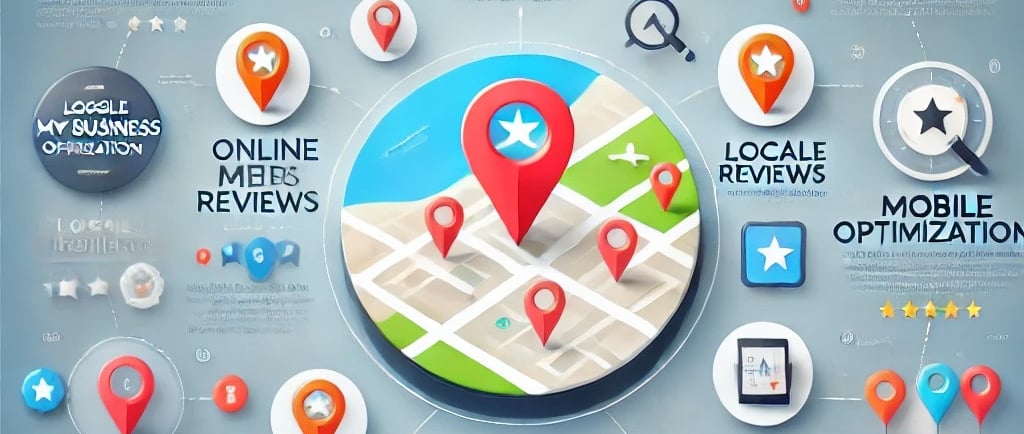What is the best strategy for local SEO?
12/27/20243 min read


What is the Best Strategy for Local SEO?
In today's digital landscape, local SEO has become essential for businesses aiming to attract customers within their geographic region. Whether you run a cozy café, a law firm, or a boutique, optimizing your online presence ensures that your business stands out in local searches. But what is the best strategy for local SEO? Let’s explore key tactics to dominate local search rankings and drive more customers to your business.
1. Optimize Your Google Business Profile
One of the most impactful steps in local SEO is claiming and optimizing your Google Business Profile (formerly Google My Business). Ensure your profile is complete with accurate information, including:
Business name
Address
Phone number (NAP)
Website URL
Hours of operation
High-quality images of your business
Encourage customers to leave reviews, as they significantly influence rankings and build trust.
2. Use Local Keywords Strategically
Local keywords are the backbone of an effective local SEO strategy. Identify terms potential customers are searching for and integrate them into:
Website content
Meta titles and descriptions
Blog posts
Service pages For example, instead of targeting "coffee shop," optimize for "best coffee shop in [City Name].
3. Create Location-Specific Content
Content marketing tailored to your local audience can significantly boost visibility. Consider writing blogs about community events, local guides, or news relevant to your industry. This approach not only increases engagement but also positions you as a local expert.
4. Ensure NAP Consistency Across Platforms
Your Name, Address, and Phone number (NAP) should be consistent across all online directories, including Yelp, Yellow Pages, and industry-specific listings. Discrepancies can confuse search engines and negatively impact your rankings.
5. Leverage Online Reviews
Positive reviews are crucial for building credibility and improving local rankings. Politely ask satisfied customers to leave reviews on Google, Yelp, or Facebook. Responding to positive and negative reviews also demonstrates your commitment to customer service.
6. Optimize for Mobile Search
With most local searches happening on mobile devices, ensuring your website is mobile-friendly is essential. Fast-loading pages, easy navigation, and click-to-call buttons enhance user experience and reduce bounce rates.
7. Focus on Local Link Building
Building relationships with local businesses and organizations can help you earn valuable backlinks. Sponsor community events, partner with local influencers, or collaborate on projects to secure links from reputable local sources.
8. Invest in Localized Social Media Marketing
Active engagement on platforms like Instagram, Facebook, and LinkedIn helps you connect with your community. Share location-specific updates, promotions, and events to maintain visibility and attract local followers.
9. Use Structured Data Markup
Implementing structured data (schema markup) on your website helps search engines understand your business better. This can enhance your chances of appearing in rich snippets or the local knowledge panel.
10. Track and Adjust Your Strategy
Local SEO is not a one-time effort. Regularly monitor your performance using tools like Google Analytics and Google Search Console. Pay attention to rankings, website traffic, and customer interactions, and adjust your strategy accordingly.
Advanced Strategies for Local SEO in 2024
To stay ahead of the competition in 2024, consider incorporating these advanced strategies:
1. Voice Search Optimization
With the growing popularity of voice assistants like Siri, Alexa, and Google Assistant, optimizing for voice search is more important than ever. Focus on conversational keywords and ensure your website answers common questions (e.g., "Where can I find a nearby coffee shop?").
2. Hyperlocal Targeting
Hyperlocal SEO narrows the focus to specific neighborhoods or areas within a city. To connect with hyperlocal audiences, use location-specific landing pages, community partnerships, and geo-targeted ads.
3. Enhance Page Experience with Core Web Vitals
Core Web Vitals are critical ranking factors, such as loading speed, interactivity, and visual stability. Optimize your website's technical performance to improve user experience and local rankings.
4. Localized Video Content
Video marketing is a powerful way to engage your audience. Create short, engaging videos that showcase your business, highlight local events, or provide helpful tips relevant to your industry and location.
5. Use Geotagged Visual Content
Geotagging photos and videos with your business location adds another layer of relevance to your local SEO efforts. It helps search engines associate your multimedia content with your area.
6. Partner with Local Influencers
Collaborating with local influencers can expand your reach and attract more customers. Look for influencers who share values aligned with your brand and have a strong presence in your community.
7. Embrace AI and Automation
Leverage AI tools to analyze customer behavior, automate local ad campaigns and personalize user experiences. Tools like ChatGPT can help craft tailored responses for reviews or generate engaging content for your audience.
Conclusion
Local SEO is a powerful tool for attracting nearby customers and growing your business. By optimizing your Google Business Profile, targeting local keywords, and maintaining NAP consistency, you can enhance your online visibility and outshine competitors in your area. Advanced tactics like voice search optimization, hyperlocal targeting, and geotagging can further cement your dominance in local search results. Stay proactive, monitor trends, and continually refine your strategy to achieve lasting success in 2024 and beyond.
Growth
Driving local business success through digital marketing.
Contact Us
© 2024. All rights reserved.
